Barometer
A barometer is a scientific instrument that is used to measure air pressure in a certain environment. Pressure tendency can forecast short term changes in the weather. Many measurements of air pressure are used within surface weather analysis to help find surface troughs, pressure systems and frontal boundaries.
Barometers and pressure altimeters (the most basic and common type of altimeter) are essentially the same instrument, but used for different purposes. An altimeter is intended to be used at different levels matching the corresponding atmospheric pressure to the altitude, while a barometer is kept at the same level and measures subtle pressure changes caused by weather and elements of weather. The average atmospheric pressure on the earth's surface varies between 940 and 1040 hPa (mbar). The average atmospheric pressure at sea level is 1013 hPa (mbar).
Etymology
The word barometer is derived from the Ancient Greek: βάρος, romanized: "baro" meaning weight, and "meter" from Ancient Greek meaning "measure".
History
Although Evangelista Torricelli is universally credited with inventing the barometer in 1643,[1][2][3] historical documentation also suggests Gasparo Berti, an Italian mathematician and astronomer, unintentionally built a water barometer sometime between 1640 and 1643.[1][4] French scientist and philosopher René Descartes described the design of an experiment to determine atmospheric pressure as early as 1631, but there is no evidence that he built a working barometer at that time.[1]
On July 27, 1630, Giovanni Battista Baliani wrote a letter to Galileo Galilei explaining an experiment he had made in which a siphon, led over a hill about twenty-one meters high, failed to work. Galileo responded with an explanation of the phenomenon: he proposed that it was the power of a vacuum that held the water up, and at a certain height the amount of water simply became too much and the force could not hold any more, like a cord that can support only so much weight.[5][6] This was a restatement of the theory of horror vacui ("nature abhors a vacuum"), which dates to Aristotle, and which Galileo restated as resistenza del vacuo.
Galileo's ideas reached Rome in December 1638 in his Discorsi. Raffaele Magiotti and Gasparo Berti were excited by these ideas, and decided to seek a better way to attempt to produce a vacuum other than with a siphon. Magiotti devised such an experiment, and sometime between 1639 and 1641, Berti (with Magiotti, Athanasius Kircher and Niccolò Zucchi present) carried it out.[6]
Four accounts of Berti's experiment exist, but a simple model of his experiment consisted of filling with water a long tube that had both ends plugged, then standing the tube in a basin already full of water. The bottom end of the tube was opened, and water that had been inside of it poured out into the basin. However, only part of the water in the tube flowed out, and the level of the water inside the tube stayed at an exact level, which happened to be 10.3 m (34 ft),[7] the same height Baliani and Galileo had observed that was limited by the siphon. What was most important about this experiment was that the lowering water had left a space above it in the tube which had no intermediate contact with air to fill it up. This seemed to suggest the possibility of a vacuum existing in the space above the water.[6]
Torricelli, a friend and student of Galileo, interpreted the results of the experiments in a novel way. He proposed that the weight of the atmosphere, not an attracting force of the vacuum, held the water in the tube. In a letter to Michelangelo Ricci in 1644 concerning the experiments, he wrote:
Many have said that a vacuum does not exist, others that it does exist in spite of the repugnance of nature and with difficulty; I know of no one who has said that it exists without difficulty and without a resistance from nature. I argued thus: If there can be found a manifest cause from which the resistance can be derived which is felt if we try to make a vacuum, it seems to me foolish to try to attribute to vacuum those operations which follow evidently from some other cause; and so by making some very easy calculations, I found that the cause assigned by me (that is, the weight of the atmosphere) ought by itself alone to offer a greater resistance than it does when we try to produce a vacuum.[8]
It was traditionally thought (especially by the Aristotelians) that the air did not have weight: that is, that the kilometers of air above the surface did not exert any weight on the bodies below it. Even Galileo had accepted the weightlessness of air as a simple truth. Torricelli questioned that assumption, and instead proposed that air had weight and that it was the latter (not the attracting force of the vacuum) which held (or rather, pushed) up the column of water. He thought that the level the water stayed at (c. 10.3 m) was reflective of the force of the air's weight pushing on it (specifically, pushing on the water in the basin and thus limiting how much water can fall from the tube into it). In other words, he viewed the barometer as a balance, an instrument for measurement (as opposed to merely being an instrument to create a vacuum), and because he was the first to view it this way, he is traditionally considered the inventor of the barometer (in the sense in which we now use the term).[6]
Because of rumors circulating in Torricelli's gossipy Italian neighborhood, which included that he was engaged in some form of sorcery or witchcraft, Torricelli realized he had to keep his experiment secret to avoid the risk of being arrested. He needed to use a liquid that was heavier than water, and from his previous association and suggestions by Galileo, he deduced by using mercury, a shorter tube could be used. With mercury, which is about 14 times denser than water, a tube only 80 cm was now needed, not 10.5 m.[9]
In 1646, Blaise Pascal along with Pierre Petit, had repeated and perfected Torricelli's experiment after hearing about it from Marin Mersenne, who himself had been shown the experiment by Torricelli toward the end of 1644. Pascal further devised an experiment to test the Aristotelian proposition that it was vapours from the liquid that filled the space in a barometer. His experiment compared water with wine, and since the latter was considered more "spiritous", the Aristotelians expected the wine to stand lower (since more vapours would mean more pushing down on the liquid column). Pascal performed the experiment publicly, inviting the Aristotelians to predict the outcome beforehand. The Aristotelians predicted the wine would stand lower. It did not.[6]
However, Pascal went even further to test the mechanical theory. If, as suspected by mechanical philosophers like Torricelli and Pascal, air had weight, the pressure would be less at higher altitudes. Therefore, Pascal wrote to his brother-in-law, Florin Perier, who lived near a mountain called the Puy de Dome, asking him to perform a crucial experiment. Perier was to take a barometer up the Puy de Dome and make measurements along the way of the height of the column of mercury. He was then to compare it to measurements taken at the foot of the mountain to see if those measurements taken higher up were in fact smaller. In September 1648, Perier carefully and meticulously carried out the experiment, and found that Pascal's predictions had been correct. The mercury barometer stood lower the higher one went.[6]
Types
Water-based barometers
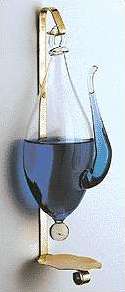
The concept that decreasing atmospheric pressure predicts stormy weather, postulated by Lucien Vidi, provides the theoretical basis for a weather prediction device called a "weather glass" or a "Goethe barometer" (named for Johann Wolfgang von Goethe, the renowned German writer and polymath who developed a simple but effective weather ball barometer using the principles developed by Torricelli). The French name, le baromètre Liègeois, is used by some English speakers.[10] This name reflects the origins of many early weather glasses – the glass blowers of Liège, Belgium.[10][11]
The weather ball barometer consists of a glass container with a sealed body, half filled with water. A narrow spout connects to the body below the water level and rises above the water level. The narrow spout is open to the atmosphere. When the air pressure is lower than it was at the time the body was sealed, the water level in the spout will rise above the water level in the body; when the air pressure is higher, the water level in the spout will drop below the water level in the body. A variation of this type of barometer can be easily made at home.[12]
Mercury barometers
A mercury barometer has a vertical glass tube closed at the top sitting in an open mercury-filled basin at the bottom. Mercury in the tube adjusts until the weight of the mercury column balances the atmospheric force exerted on the reservoir. High atmospheric pressure places more force on the reservoir, forcing mercury higher in the column. Low pressure allows the mercury to drop to a lower level in the column by lowering the force placed on the reservoir. Since higher temperature levels around the instrument will reduce the density of the mercury, the scale for reading the height of the mercury is adjusted to compensate for this effect. The tube has to be at least as long as the amount dipping in the mercury + head space + the maximum length of the column.

Torricelli documented that the height of the mercury in a barometer changed slightly each day and concluded that this was due to the changing pressure in the atmosphere.[1] He wrote: "We live submerged at the bottom of an ocean of elementary air, which is known by incontestable experiments to have weight".[13] Inspired by Torricelli, Otto von Guericke on 5 December 1660 found that air pressure was unusually low and predicted a storm, which occurred the next day.[14]
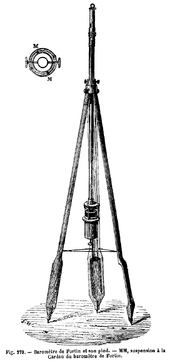
The mercury barometer's design gives rise to the expression of atmospheric pressure in inches or millimeters of mercury (mmHg). A torr was originally defined as 1 mmHg. The pressure is quoted as the level of the mercury's height in the vertical column. Typically, atmospheric pressure is measured between 26.5 inches (670 mm) and 31.5 inches (800 mm) of Hg. One atmosphere (1 atm) is equivalent to 29.92 inches (760 mm) of mercury.
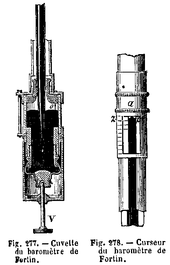
Design changes to make the instrument more sensitive, simpler to read, and easier to transport resulted in variations such as the basin, siphon, wheel, cistern, Fortin, multiple folded, stereometric, and balance barometers.
On June 5, 2007, a European Union directive was enacted to restrict the sale of mercury, thus effectively ending the production of new mercury barometers in Europe.[15]
Fitzroy barometer
Fitzroy barometers combine the standard mercury barometer with a thermometer, as well as a guide of how to interpret pressure changes.
Fortin barometer
Fortin barometers use a variable displacement mercury cistern, usually constructed with a thumbscrew pressing on a leather diaphragm bottom (V in the diagram). This compensates for displacement of mercury in the column with varying pressure. To use a Fortin barometer, the level of mercury is set to zero by using the thumbscrew to make an ivory pointer (O in the diagram) just touch the surface of the mercury. The pressure is then read on the column by adjusting the vernier scale so that the mercury just touches the sightline at Z.. Some models also employ a valve for closing the cistern, enabling the mercury column to be forced to the top of the column for transport. This prevents water-hammer damage to the column in transit.
Wheel Barometers
A wheel barometer uses a "J" tube sealed at the top of the longer limb. The shorter limb is open to the atmosphere and floating on top of the mercury there is a small glass float. A fine silken thread is attached to the float which passes up over a wheel and then back down to a counterweight (usually protected in another tube). The wheel turns the point on the front of the barometer. As atmospheric pressure increases mercury moves from the short to the long limb, the float falls and the pointer moves. When pressure increases the mercury moves back, lifting the float and turning the dial the other way.[16]
Around 1810 the wheel barometer, which could be read from a great distance, became the first practical and commercial instrument favoured by farmers and the educated classes in the UK. The face of the barometer was circular with a simple dial pointing to an easily readable scale: "Rain - Change - Dry" with the "Change" at the top centre of the dial. Later models added a barometric scale with finer graduations "Stormy (28 inches of mercury), Much Rain (28.5), Rain (29), Change (29.5), Fair (30), Set fair (30.5), very dry(31)".
Natalo Aiano is recognised as one of the finest makers of wheel barometers, an early pioneer in a wave of artisanal Italian instrument and barometer makers that were encouraged to emigrate to the UKItalians in the United Kingdom#15th to 18th centuries. He listed as working in Holborn, London c.1785-1805[17]. From 1770 onwards a large number of Italians came to England because they were accomplished glass blowers or instrument makers. By 1840 it was fair to say that the Italians dominated the industry in England.[18]
Vacuum pump oil barometer
Using vacuum pump oil as the working fluid in a barometer has led to the creation of the new "World's Tallest Barometer" in February 2013. The barometer at Portland State University (PSU) uses doubly distilled vacuum pump oil and has a nominal height of about 12.4 m for the oil column height; expected excursions are in the range of ±0.4 m over the course of a year. Vacuum pump oil has very low vapour pressure and it is available in a range of densities; the lowest density vacuum oil was chosen for the PSU barometer to maximize the oil column height.[19]
Aneroid barometers
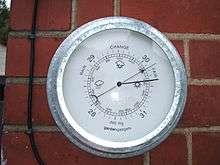
An aneroid barometer is an instrument used for measuring pressure as a method that does not involve liquid. Invented in 1844 by French scientist Lucien Vidi,[20] the aneroid barometer uses a small, flexible metal box called an aneroid cell (capsule), which is made from an alloy of beryllium and copper. The evacuated capsule (or usually several capsules, stacked to add up their movements) is prevented from collapsing by a strong spring. Small changes in external air pressure cause the cell to expand or contract. This expansion and contraction drives mechanical levers such that the tiny movements of the capsule are amplified and displayed on the face of the aneroid barometer. Many models include a manually set needle which is used to mark the current measurement so a change can be seen. This type of barometer is common in homes and in recreational boats. It is also used in meteorology, mostly in barographs and as a pressure instrument in radiosondes.
Barographs
A barograph is a recording aneroid barometer where the changes in atmospheric pressure are recorded on a paper chart.
The principle of the barograph is same as that of the aneroid barometer. Whereas the barometer displays the pressure on a dial, the barograph uses the small movements of the box to transmit by a system of levers to a recording arm that has at its extreme end either a scribe or a pen. A scribe records on smoked foil while a pen records on paper using ink, held in a nib. The recording material is mounted on a cylindrical drum which is rotated slowly by a clock. Commonly, the drum makes one revolution per day, per week, or per month and the rotation rate can often be selected by the user.
MEMS Barometers
Micro Electro Mechanical Systems (or MEMS) barometers are extremely small devices between 1 and 100 micrometres in size (0.001 to 0.1 mm). They are created via photolithography or photochemical machining. Typical applications include miniaturized weather stations, electronic barometers and altimeters.[21]
A barometer can also be found in smartphones such as the Samsung Galaxy Nexus,[22] Samsung Galaxy S3-S6, Motorola Xoom, Apple iPhone 6 smartphones, and Timex Expedition WS4 smartwatch, based on MEMS and piezoresistive pressure-sensing technologies.[23][24] Inclusion of barometers on smartphones was originally intended to provide a faster GPS lock.[25] However, third party researchers were unable to confirm additional GPS accuracy or lock speed due to barometric readings. The researchers suggest that the inclusion of barometers in smartphones may provide a solution for determining a user's elevation, but also suggest that several pitfalls must first be overcome.[26]
More unusual barometers

There are many other more unusual types of barometer. From variations on the storm barometer, such as the Collins Patent Table Barometer, to more traditional-looking designs such as Hooke's Otheometer and the Ross Sympiesometer. Some, such as the Shark Oil barometer,[27] work only in a certain temperature range, achieved in warmer climates.

Applications
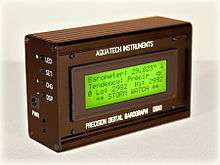
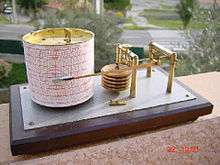
Barometric pressure and the pressure tendency (the change of pressure over time) have been used in weather forecasting since the late 19th century.[29] When used in combination with wind observations, reasonably accurate short-term forecasts can be made.[30] Simultaneous barometric readings from across a network of weather stations allow maps of air pressure to be produced, which were the first form of the modern weather map when created in the 19th century. Isobars, lines of equal pressure, when drawn on such a map, give a contour map showing areas of high and low pressure.[31] Localized high atmospheric pressure acts as a barrier to approaching weather systems, diverting their course. Atmospheric lift caused by low-level wind convergence into the surface brings clouds and sometimes precipitation.[32] The larger the change in pressure, especially if more than 3.5 hPa (0.1 inHg), the greater the change in weather that can be expected. If the pressure drop is rapid, a low pressure system is approaching, and there is a greater chance of rain. Rapid pressure rises, such as in the wake of a cold front, are associated with improving weather conditions, such as clearing skies.[33]
With falling air pressure, gases trapped within the coal in deep mines can escape more freely. Thus low pressure increases the risk of firedamp accumulating. Collieries therefore keep track of the pressure. In the case of the Trimdon Grange colliery disaster of 1882 the mines inspector drew attention to the records and in the report stated "the conditions of atmosphere and temperature may be taken to have reached a dangerous point".[34]
Aneroid barometers are used in scuba diving. A submersible pressure gauge is used to keep track of the contents of the diver's air tank. Another gauge is used to measure the hydrostatic pressure, usually expressed as a depth of sea water. Either or both gauges may be replaced with electronic variants or a dive computer.[35]
Compensations
Temperature
The density of mercury will change with increase or decrease in temperature, so a reading must be adjusted for the temperature of the instrument. For this purpose a mercury thermometer is usually mounted on the instrument. Temperature compensation of an aneroid barometer is accomplished by including a bi-metal element in the mechanical linkages. Aneroid barometers sold for domestic use typically have no compensation under the assumption that they will be used within a controlled room temperature range.
Altitude
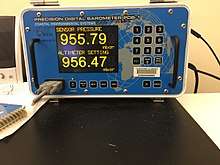
As the air pressure decreases at altitudes above sea level (and increases below sea level) the uncorrected reading of the barometer will depend on its location. The reading is then adjusted to an equivalent sea-level pressure for purposes of reporting. For example, if a barometer located at sea level and under fair weather conditions is moved to an altitude of 1,000 feet (305 m), about 1 inch of mercury (~35 hPa) must be added on to the reading. The barometer readings at the two locations should be the same if there are negligible changes in time, horizontal distance, and temperature. If this were not done, there would be a false indication of an approaching storm at the higher elevation.
Aneroid barometers have a mechanical adjustment that allows the equivalent sea level pressure to be read directly and without further adjustment if the instrument is not moved to a different altitude. Setting an aneroid barometer is similar to resetting an analog clock that is not at the correct time. Its dial is rotated so that the current atmospheric pressure from a known accurate and nearby barometer (such as the local weather station) is displayed. No calculation is needed, as the source barometer reading has already been converted to equivalent sea-level pressure, and this is transferred to the barometer being set—regardless of its altitude. Though somewhat rare, a few aneroid barometers intended for monitoring the weather are calibrated to manually adjust for altitude. In this case, knowing either the altitude or the current atmospheric pressure would be sufficient for future accurate readings.
The table below shows examples for three locations in the city of San Francisco, California. Note the corrected barometer readings are identical, and based on equivalent sea-level pressure. (Assume a temperature of 15 °C.)
| Location | Altitude (feet) | Uncorrected Patm (inches Hg) | Corrected Patm (inches Hg) | Altitude (metres) | Uncorrected Patm (hPa) | Corrected Patm (hPa) | |
|---|---|---|---|---|---|---|---|
| City Marina | Sea Level (0) | 29.92 | 29.92 | 0 m | 1013 hPa | 1013 hPa | |
| Nob Hill | 348 | 29.55 | 29.92 | 106 m | 1001 hPa | 1013 hPa | |
| Mt. Davidson | 928 | 28.94 | 29.92 | 283 m | 980 hPa | 1013 hPa |
In 1787, during a scientific expedition on Mont Blanc, De Saussure undertook research and executed physical experiments on the boiling point of water at different heights. He calculated the height at each of his experiments by measuring how long it took an alcohol burner to boil an amount of water, and by these means he determined the height of the mountain to be 4775 metres. (This later turned out to be 32 metres less than the actual height of 4807 metres). For these experiments De Saussure brought specific scientific equipment, such as a barometer and thermometer. His calculated boiling temperature of water at the top of the mountain was fairly accurate, only off by 0.1 kelvin.[36]
Based on his findings, the altimeter could be developed as a specific application of the barometer. In the mid-19th century, this method was used by explorers.[37]
Equation
When atmospheric pressure is measured by a barometer, the pressure is also referred to as the "barometric pressure". Assume a barometer with a cross-sectional area A, a height h, filled with mercury from the bottom at Point B to the top at Point C. The pressure at the bottom of the barometer, Point B, is equal to the atmospheric pressure. The pressure at the very top, Point C, can be taken as zero because there is only mercury vapour above this point and its pressure is very low relative to the atmospheric pressure. Therefore, one can find the atmospheric pressure using the barometer and this equation:[38]
- Patm = ρgh
where ρ is the density of mercury, g is the gravitational acceleration, and h is the height of the mercury column above the free surface area. The physical dimensions (length of tube and cross-sectional area of the tube) of the barometer itself have no effect on the height of the fluid column in the tube.
In thermodynamic calculations, a commonly used pressure unit is the "standard atmosphere". This is the pressure resulting from a column of mercury of 760 mm in height at 0 °C. For the density of mercury, use ρHg = 13,595 kg/m3 and for gravitational acceleration use g = 9.807 m/s2.
If water were used (instead of mercury) to meet the standard atmospheric pressure, a water column of roughly 10.3 m (33.8 ft) would be needed.
Standard atmospheric pressure as a function of elevation:
Note: 1 torr = 133.3 Pa = 0.03937 inHg
| Patm / kPa | Altitude | Patm / inHg | Altitude | |
|---|---|---|---|---|
| 101.325 | Sea Level (0m) | 29.92 | Sea Level (0 ft) | |
| 97.71 | 305 m | 28.86 | 1,000 ft | |
| 94.21 | 610 m | 27.82 | 2,000 ft | |
| 89.88 | 1,000 m | 26.55 | 3,281 ft | |
| 84.31 | 1,524 m | 24.90 | 5,000 ft | |
| 79.50 | 2,000 m | 23.48 | 6,562 ft | |
| 69.68 | 3,048 m | 20.58 | 10,000 ft | |
| 54.05 | 5,000 m | 15.96 | 16,404 ft | |
| 46.56 | 6,096 m | 13.75 | 20,000 ft | |
| 37.65 | 7,620 m | 11.12 | 25,000 ft | |
| 32.77 | 8,848 m* | 9.68 | 29,029 ft* | |
| 26.44 | 10,000 m | 7.81 | 32,808 ft | |
| 11.65 | 15,240 m | 3.44 | 50,000 ft | |
| 5.53 | 20,000 m | 1.63 | 65,617 ft |
- Elevation of Mount Everest, the highest point on earth
Patents
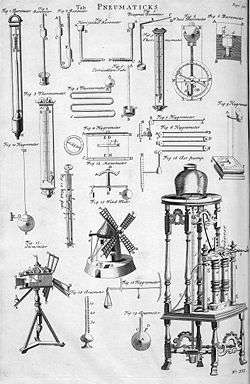
- US 2194624, G. A. Titterington, Jr, "Diaphragm pressure gauge having temperature compensating means", issued 1940-03-26, assigned to Bendix Aviat Corp
- U.S. Patent 2,472,735 : C. J. Ulrich : "Barometric instrument"
- U.S. Patent 2,691,305 : H. J. Frank : "Barometric altimeter"
- U.S. Patent 3,273,398 : D. C. W. T. Sharp : "Aneroid barometer"
- U.S. Patent 3,397,578 : H. A. Klumb : "Motion amplifying mechanism for pressure responsive instrument movement"
- U.S. Patent 3,643,510 : F. Lissau : "Fluid displacement pressure gauges"
- U.S. Patent 4,106,342 : O. S. Sormunen : "Pressure measuring instrument"
- U.S. Patent 4,238,958 : H. Dostmann : "Barometer"
- U.S. Patent 4,327,583 : T. Fijimoto : "Weather forecasting device"
See also
References
- "The Invention of the Barometer". Islandnet.com. Retrieved 2010-02-04.
- "History of the Barometer". Barometerfair.com. Archived from the original on 2009-09-25. Retrieved 2010-02-04.
- "Evangelista Torricelli, The Invention of the Barometer". Juliantrubin.com. Archived from the original on 9 February 2010. Retrieved 2010-02-04.
- Drake, Stillman (1970). "Berti, Gasparo". Dictionary of Scientific Biography. 2. New York: Charles Scribner's Sons. pp. 83–84. ISBN 978-0-684-10114-9.
- Shea, William R. (2003). Designing Experiments & Games of Chance: The Unconventional Science of Blaise Pascal. Science History Publications. pp. 21–. ISBN 978-0-88135-376-1. Retrieved 10 October 2012.
- "History of the Barometer". Strange-loops.com. 2002-01-21. Archived from the original on 6 January 2010. Retrieved 2010-02-04.
- Gillispie, Charles Coulston (1960). The Edge of Objectivity: An Essay in the History of Scientific Ideas. Princeton University Press. pp. 99–100. ISBN 0-691-02350-6.
- "Torricelli's letter to Michelangelo Ricci". Web.lemoyne.edu. Retrieved 2010-02-04.
- "Brief History of the Barometer". Barometer.ws. Archived from the original on 14 January 2010. Retrieved 2010-02-04.
- Gerard L'E. Turner, Nineteenth Century Scientific Instruments, Sotheby Publications, 1983, p 236, ISBN 0-85667-170-3
- Claus Zittle, Philosophies of Technology: Francis Bacon and His Contemporaries, BRILL 2008, pp 115, 116 ISBN 90-04-17050-2
- Jet Stream. Learning Lesson: Measure the Pressure – The "Wet" Barometer. Retrieved on 2019-01-21.
- Strangeways, Ian. Measuring the Natural Environment. Cambridge University Press, 2000, p. 92.
- Ley, Willy (June 1966). "The Re-Designed Solar System". For Your Information. Galaxy Science Fiction. pp. 94–106.
- Jones H. (10 July 2007). "EU bans mercury in barometers, thermometers". Reuters. Retrieved 12 September 2017.
- Hood, Jean (5 December 2017). "Barometers : History, working and styles". Retrieved 21 June 2020.
- "Natalo Aiano". About us page. C. Aiano & Sons Ltd.
- Nicholas, Goodison (1977). English barometers 1680-1860 : a history of domestic barometers and their makers and retailers (Rev. and enl. ed.). Antique Collectors' Club. ISBN 978-0902028524.
- Tomlinson, Stuart (February 10, 2013) Large barometer at Portland State University could be the tallest in the world. oregonlive.com
- Figuier, Louis; Gautier, Émile (1867). L'Année scientifique et industrielle. L. Hachette et cie. pp. 485–486.
- "MEMS Barometric Pressure Sensor". Sensors & Transducers E-Digest. 92 (4). 2008. Retrieved 13 June 2014.
- This Is the Samsung Galaxy Nexus, Google's New Official Android Phone. Gizmodo.com (2011-10-18). Retrieved on 2011-11-15.
- Molen, Brad (2011-10-20). "Behind the glass: a detailed tour inside the Samsung Galaxy Nexus". Engadget. Engadget. Archived from the original on 2014-12-05. Retrieved 2015-06-23.
Barometric pressure sensor: BOSCH BMP180
- "BMP180: Digital, barometric pressure sensor" (PDF). Bosch. Archived from the original (PDF) on 2015-06-23. Retrieved 2015-06-23.
- Galaxy Nexus barometer explained, Sam Champion not out of a job. Engadget (2011-10-20). Retrieved on 2011-12-03.
- Muralidharan, Kartik; Khan, Azeem Javed; Misra, Archan; Balan, Rajesh Krishna; Agarwal, Sharad (2014-02-26). "Barometric Phone Sensors – More Hype Than Hope!". ACM HotMobile: 2. Retrieved 2015-06-23.
- Shark Oil Barometer Archived July 20, 2011, at the Wayback Machine Barometer World.
- Galaxy Nexus. Google.com. Retrieved on 2011-12-03.
- Understanding air pressure. USA Today.
- Using winds and a barometer to make forecasts. USA Today (17 May 2005).
- Hopkins, Edward J. (1996-06-10). "Surface Weather Analysis Chart". University of Wisconsin. Archived from the original on 28 April 2007. Retrieved 2007-05-10.
- Pearce, Robert Penrose (2002). Meteorology at the Millennium. Academic Press. p. 66. ISBN 978-0-12-548035-2. Retrieved 2009-01-02.
- Applying The Barometer To Weather Watching. Weather Doctor.
- Report on the Explosion which occurred at the Trimdon Grange Colliery on the 16th February 1882, retrieved 23 July 2015
- The Encyclopedia of Recreational Diving. Santa Ana, CA, USA: Professional Association of Diving Instructors. 1990. pp. 3–96–3–99. ISBN 978-1-878663-02-3.
- "Kelvin scale in depth". Retrieved 12 February 2020.
- Berberan-Santos, M. N.; Bodunov, E. N.; Pogliani, L. (1997). "On the barometric formula". American Journal of Physics. 65 (5): 404–412. Bibcode:1997AmJPh..65..404B. doi:10.1119/1.18555.
- Cengal, Yunus A. and Boles, Michael A. (2014) Thermodynamics: An Engineering Approach. McGraw-Hill Education. ISBN 978-0073398174
Further reading
- . Encyclopædia Britannica. 3 (11th ed.). 1911.
- Burch, David F. The Barometer Handbook; a modern look at barometers and applications of barometric pressure. Seattle: Starpath Publications (2009), ISBN 978-0-914025-12-2.
- Middleton, W. E. Knowles. (1964). The history of the barometer. Baltimore: Johns Hopkins Press. New edition (2002), ISBN 0-8018-7154-9.
External links
| Wikimedia Commons has media related to Barometers. |
